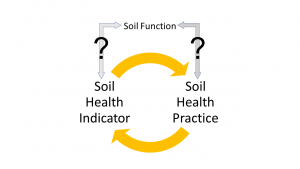There is a problem with how soil health indicators are being developed. We start with farmers using soil health practices, for instance, no-till, crop rotation, cover crops, and application of manure or compost. Then we look for indicators that are sensitive to the use of these soil health practices. Then we use the most sensitive indicators to measure “the effects” of soil health practices. Do you see the problem?
Using this method, what indicators are actually showing is the use of the soil health practice because that is what they were selected to do. It’s circular logic. We end up with measurements that are great indicators of the use of soil health practices, but that may or may not be correlated with actual soil function:
Soil health practices are beneficial, but they are not the same as soil health: they are not soil function. Consider tillage. It is not a soil health practice, but farmers use tillage because it can improve some soil properties in the short-term. Increases in aeration, water infiltration, and decreases in root penetration resistance are benefits of tillage, but with the way soil health indicators are chosen, they would not reflect these short-term improvements because they are selected to be sensitive to the no-till practice, not the resulting soil properties. If improved soil function is the goal and not increasing soil health indicators, a change is needed.
Using the same approach to human health, we might find a good “human health” indicator would be time spent at walking because it is sensitive to the human health practice of exercising. However, if your problem is skin cancer, this indicator would miss it completely.
This gets back to a question I asked in a previous post, “What’s the problem with my soil?” There, I suggested that identifying the problem and managing to solve that problem was a better strategy than pursuing a fuzzy notion of soil health… or than using a soil health indicator that is more indicative of your practices than your soil’s function.
There are people working to solve this problem, but until then, focusing on your specific problems. If you have no problems, then it is a good assumption that you have soil health, whether the indicators tell you so or not.
References
- Here is one example of this. Researchers are looking at soil microbiome indicators in the same manner.
- Thanks to Jordon Wade for first pointing this out to me. He is lead author on this paper (open access) that aims to address this problem:
Wade, J., S.W. Culman, J.A.R. Logan, H. Poffenbarger, M.S. Demyan, et al. 2020. Improved soil biological health increases corn grain yield in N fertilized systems across the Corn Belt. Scientific Reports 10(1): 1–9. doi: 10.1038/s41598-020-60987-3.
![[Comic] King (farmers) with bow. Peasant (researchers) paints targets (soil health indicators) around already-shot arrows (soil health practices).](https://s3.us-west-2.amazonaws.com/wp2.cahnrs.wsu.edu/wp-content/uploads/sites/32/2022/04/Soil-health-indicators-problem-color2-300x169.png)

Comments
[…] There is a problem with how soil health indicators are being developed. We start with farmers using soil health practices, for instance, no-till, crop rotation, cover crops, and application of manure or compost. Then we look for indicators that are sensitive to the use of these soil health practices. Then we use the most sensitive indicators to measure “the effects” of soil health practices. Do you see the problem? […]